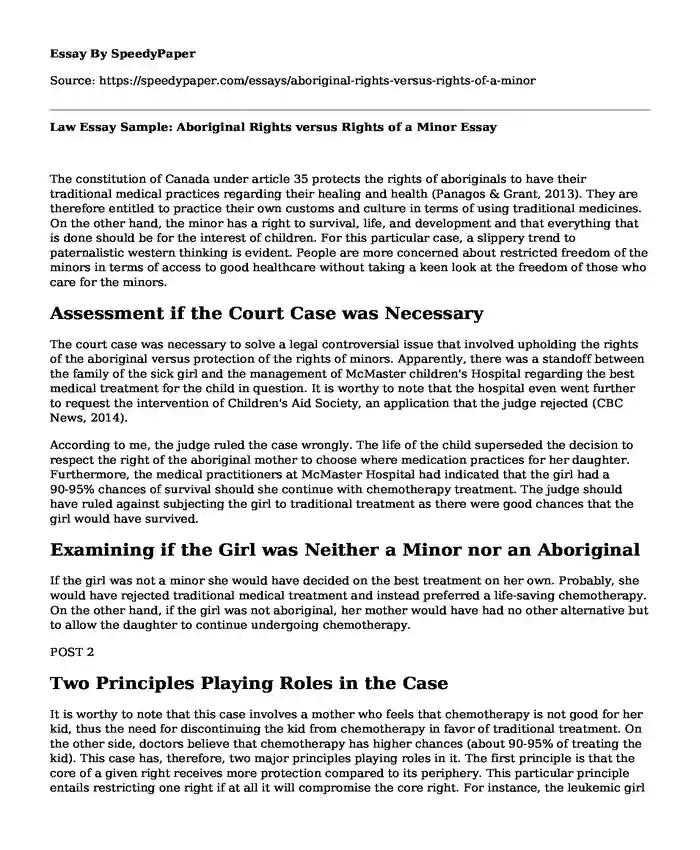The constitution of Canada under article 35 protects the rights of aboriginals to have their traditional medical practices regarding their healing and health (Panagos & Grant, 2013). They are therefore entitled to practice their own customs and culture in terms of using traditional medicines. On the other hand, the minor has a right to survival, life, and development and that everything that is done should be for the interest of children. For this particular case, a slippery trend to paternalistic western thinking is evident. People are more concerned about restricted freedom of the minors in terms of access to good healthcare without taking a keen look at the freedom of those who care for the minors.
Assessment if the Court Case was Necessary
The court case was necessary to solve a legal controversial issue that involved upholding the rights of the aboriginal versus protection of the rights of minors. Apparently, there was a standoff between the family of the sick girl and the management of McMaster children's Hospital regarding the best medical treatment for the child in question. It is worthy to note that the hospital even went further to request the intervention of Children's Aid Society, an application that the judge rejected (CBC News, 2014).
According to me, the judge ruled the case wrongly. The life of the child superseded the decision to respect the right of the aboriginal mother to choose where medication practices for her daughter. Furthermore, the medical practitioners at McMaster Hospital had indicated that the girl had a 90-95% chances of survival should she continue with chemotherapy treatment. The judge should have ruled against subjecting the girl to traditional treatment as there were good chances that the girl would have survived.
Examining if the Girl was Neither a Minor nor an Aboriginal
If the girl was not a minor she would have decided on the best treatment on her own. Probably, she would have rejected traditional medical treatment and instead preferred a life-saving chemotherapy. On the other hand, if the girl was not aboriginal, her mother would have had no other alternative but to allow the daughter to continue undergoing chemotherapy.
POST 2
Two Principles Playing Roles in the Case
It is worthy to note that this case involves a mother who feels that chemotherapy is not good for her kid, thus the need for discontinuing the kid from chemotherapy in favor of traditional treatment. On the other side, doctors believe that chemotherapy has higher chances (about 90-95% of treating the kid). This case has, therefore, two major principles playing roles in it. The first principle is that the core of a given right receives more protection compared to its periphery. This particular principle entails restricting one right if at all it will compromise the core right. For instance, the leukemic girl was an aboriginal with the rights to a traditional medical treatment option. Denying the mother the right to treat her daughter through traditional ways would be against the rights of the aboriginal. In this regard, the right of an aboriginal to have their traditional practices acted as a core right whereas the right of the minor to receive proper medical treatment acted as a periphery right since the minor is an aboriginal (Ontario Human Rights Commission, n.d.).
Another principle of ethics applicable in this case is beneficence which promotes and encourages the best treatment for a patient. In the case in which the mother went to court in order to be allowed to treat her daughter using the traditional method, the doctors at McMaster children's Hospital believed that chemotherapy was the best healthcare practice for the girl that suffered from lymphoblastic leukemia. Thus, they did everything possible within the confines of the law such as seeking an application for Children's Aid Society to arbitrate in the case, a move that Judge Gethin Edward rejected. Therefore, it is prudent to adduce that the principle that the core of a given right receives more protection compared to its periphery and the principle of beneficence are the major principles in this particular case.
References
CBC News (2014). Legal experts debate aboriginal right to refuse chemo for child | CBC News. [online] Available at: www.cbc.ca/news/aboriginal/aboriginal-right-to-refuse-chemotherapy-for-child-spurs-debate-1.2854317 [Accessed 28 Apr. 2018].
Ontario Human Rights Commission. (n.d.). 5. Key legal principles [20]. [online] Available at: www.ohrc.on.ca/en/policy-competing-human-rights/5-key-legal-principles-20 [Accessed 28 Apr. 2018].
Panagos, D., & Grant, J. A. (2013). Constitutional change, Aboriginal rights, and mining policy in Canada. Commonwealth & Comparative Politics, 51(4), 405-423.
Cite this page
Law Essay Sample: Aboriginal Rights versus Rights of a Minor. (2022, May 26). Retrieved from https://speedypaper.com/essays/aboriginal-rights-versus-rights-of-a-minor
Request Removal
If you are the original author of this essay and no longer wish to have it published on the SpeedyPaper website, please click below to request its removal:
- Competitive Advantage of EasyJet and Ryanair - Free Essay on Business
- Free Essay Sample on Media Texts
- Free Essay for Students on Cultural Linguistics
- Free Essay on General Social Anxiety Disorder and Social Anxiety Disorder
- Annotated Bibliography on How to Start a Business, Free Paper Example for Students
- Essay Sample Answering the Questions Concerning Federal System in the US
- Free Essay Example on Healthcare Reforms
Popular categories





